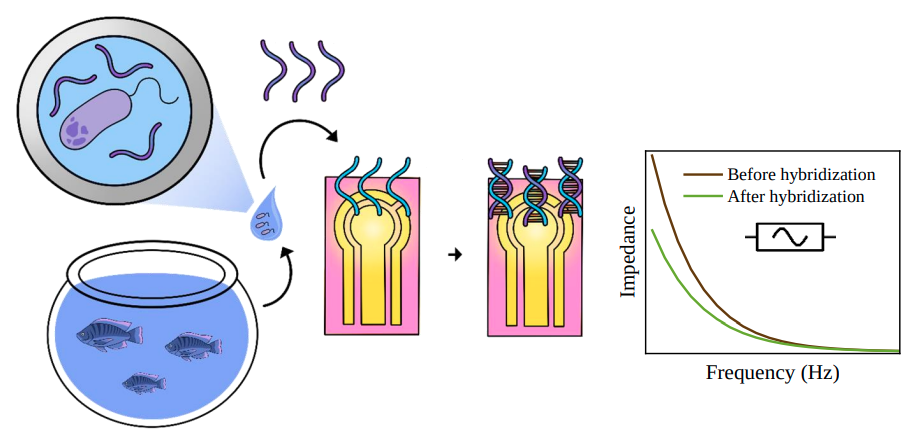Vibrio vulnificus (Vv) is a marine pathogen that can cause rapid death by septicemia (vibriosis) in humans and several fish species. This pathogen is considered a biomarker of climate change, as both its presence and vibriosis incidence in coastal environments are increasing because of global warming. Currently, gold-standard methods for Vv detection are all PCR-based, requiring expensive equipment and skilled personnel, which hinders their use on a global scale. The aim of this work was to design and test a more affordable method that could be used worldwide for both vibriosis diagnosis and pathogen monitoring in water. To this end, we functionalized thin film microelectrodes with thiolated single-stranded DNA sequences complementary to the species-specific genetic marker, the gene vvha, and monitored the impedance changes upon hybridization. We tested the biosensor specificity with synthetic and natural DNA samples (from cultures of Vv and V. cholerae, a closely related species) and determined the detectable concentration range. The results obtained showed that this biosensor was specific for Vv, achieving detection down to 1 pM DNA, which corresponds approximately to 3x102 bacteria/mL. Consequently, this biosensor could be used on a global scale for vibriosis diagnostics, health risk studies and climate change monitoring, with potential application for in situ detection.

Vibrio vulnificus (Vv) is a marine pathogen that can cause rapid death by septicemia (vibriosis) in humans and several fish species. This pathogen is considered a biomarker of climate change, as both its presence and vibriosis incidence in coastal environments are increasing because of global warming. Currently, gold-standard methods for Vv detection are all PCR-based, requiring expensive equipment and skilled personnel, which hinders their use on a global scale. The aim of this work was to design and test a more affordable method that could be used worldwide for both vibriosis diagnosis and pathogen monitoring in water. To this end, we functionalized thin film microelectrodes with thiolated single-stranded DNA sequences complementary to the species-specific genetic marker, the gene vvha, and monitored the impedance changes upon hybridization. We tested the biosensor specificity with synthetic and natural DNA samples (from cultures of Vv and V. cholerae, a closely related species) and determined the detectable concentration range. The results obtained showed that this biosensor was specific for Vv, achieving detection down to 1 pM DNA, which corresponds approximately to 3x102 bacteria/mL. Consequently, this biosensor could be used on a global scale for vibriosis diagnostics, health risk studies and climate change monitoring, with potential application for in situ detection.
